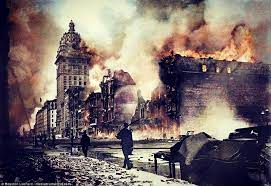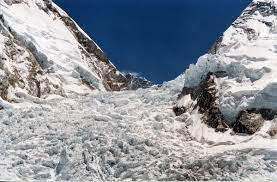The Great San Francisco Earthquake topples buildings, killing thousands
On April 18, 1906, at 5:13 a.m., an earthquake estimated at close to 8.0 on the Richter scale strikes San Francisco, California, killing an estimated 3,000 people as it topples numerous buildings. The quake was caused by a slip of the San Andreas Fault over a segment about 275 miles long, and shock waves could be felt from southern Oregon down to Los Angeles.
San Francisco’s brick buildings and wooden Victorian structures were especially devastated. Fires immediately broke out and–because broken water mains prevented firefighters from stopping them–firestorms soon developed citywide. At 7 a.m., U.S. Army troops from Fort Mason reported to the Hall of Justice, and San Francisco Mayor E.E. Schmitz called for the enforcement of a dusk-to-dawn curfew and authorized soldiers to shoot-to-kill anyone found looting. Meanwhile, in the face of significant aftershocks, firefighters and U.S. troops fought desperately to control the ongoing fire, often dynamiting whole city blocks to create firewalls. On April 20, 20,000 refugees trapped by the massive fire were evacuated from the foot of Van Ness Avenue onto the USS Chicago.
By April 23, most fires were extinguished, and authorities commenced the task of rebuilding the devastated metropolis. It was estimated that some 3,000 people died as a result of the Great San Francisco Earthquake and the devastating fires it inflicted upon the city. Almost 30,000 buildings were destroyed, including most of the city’s homes and nearly all the central business district.
EXPLORATION
2014
Mt. Everest sees its single deadliest day
On April 18, 2014, 16 Nepali mountaineering guides, most of them ethnic Sherpas, are killed by an avalanche on Mt. Everest. It was the single deadliest accident in the history of the Himalayan peak, which rises more than 29,000 feet above sea level and lies across the border between Nepal and China. The avalanche, which occurred around 6:30 a.m., swept over the Sherpas in a notoriously treacherous area of Everest known as the Khumbu Icefall, at approximately 19,000 feet. At the time, the Sherpas had been hauling loads of gear for commercial expedition groups. The disaster, in which no foreigners were killed, reopened debates about the dangerous risks undertaken by Sherpas for their typically affluent clients (in addition to lugging most of the supplies for an expedition, Sherpas are responsible for such tasks as setting lines of fixed ropes and ladders for climbers), as well as the over-commercialization of Everest, where human traffic jams during the spring mountaineering season and massive amounts of litter have become common.
ART, LITERATURE, AND FILM HISTORY
2012
Dick Clark, host of “American Bandstand” and “New Year’s Rockin’ Eve,” dies
On April 18, 2012, Dick Clark, the TV personality and producer best known for hosting “American Bandstand,” an influential music-and-dance show that aired nationally from 1957 to 1989 and helped bring rock `n’ roll into the mainstream in the late 1950s, dies of a heart attack at age 82 in Santa Monica, California. The clean-cut, youthful-looking Clark, dubbed “America’s Oldest Teenager,” also was the longtime host of the annual telecast “New Year’s Rockin’ Eve” and headed an entertainment empire that developed game shows, awards shows, talk shows, made-for-TV movies and other programs.
MIDDLE EAST
1983
Suicide bomber destroys U.S. embassy in Beirut
The U.S. embassy in Beirut, Lebanon, is almost completely destroyed by a car-bomb explosion that kills 63 people, including the suicide bomber and 17 Americans. The terrorist attack was carried out in protest of the U.S. military presence in Lebanon. In 1975, a bloody civil war erupted in Lebanon, with Palestinian and leftist Muslim guerrillas battling militias of the Christian Phalange Party, the Maronite Christian community, and other groups. During the next few years, Syrian, Israeli, and United Nations interventions failed to resolve the factional fighting, and on August 20, 1982, a multinational force featuring U.S. Marines landed in Beirut to oversee the Palestinian withdrawal from Lebanon.
REFORMATION
1521
Martin Luther defiant at Diet of Worms
Martin Luther, the chief catalyst of Protestantism, defies the Holy Roman Emperor Charles V by refusing to recant his writings. He had been called to Worms, Germany, to appear before the Diet (assembly) of the Holy Roman Empire and answer charges of heresy.
WORLD WAR II
1945
War correspondent Ernie Pyle killed
During World War II, journalist Ernie Pyle, America’s most popular war correspondent, is killed by Japanese machine-gun fire on the island of Ie Shima in the Pacific. Pyle, born in Dana, Indiana, first began writing a column for the Scripps-Howard newspaper chain in 1935.
WORLD WAR II
1942
Doolittle leads air raid on Tokyo
On April 18, 1942, 16 American B-25 bombers, launched from the aircraft carrier USS Hornet 650 miles east of Japan and commanded by Lieutenant Colonel James H. Doolittle, attack the Japanese mainland. The now-famous Tokyo Raid did little real damage to Japan (wartime Premier Hideki Tojo was inspecting military bases during the raid; one B-25 came so close, Tojo could see the pilot, though the American bomber never fired a shot)–but it did hurt the Japanese government’s prestige. Believing the air raid had been launched from Midway Island, approval was given to Admiral Isoroku Yamamoto’s plans for an attack on Midway–which would also damage Japanese “prestige.” Doolittle eventually received the Medal of Honor. A book describing the raid, 30 Seconds Over Tokyo by Ted Lawson, was adapted into a film starring Spencer Tracy in 1944.
SPORTS
1983
Joan Benoit wins Boston Marathon
Joan Benoit wins her second Boston Marathon in the women’s division with a time of 2:22:43 on April 18, 1983. The following year, she went on to win the first-ever women’s marathon at the Summer Olympic Games in Los Angeles and became the first person to win Boston as well as Olympic gold. A native of Maine, Benoit turned to long-distance running in high school after a ski injury. In 1979, as a senior at Bowdoin College, Benoit won her first Boston Marathon with a time of 2:35:15. Four years later, on April 18, 1983, Benoit won her second Boston Marathon, with a record time of 2:22:43. Greg Meyer of Massachusetts was the men’s winner that year, with a time of 2:09:00. As of 2007, Meyer was the last American man to win the Boston Marathon, which has been dominated by Kenyans in recent decades.
ART, LITERATURE, AND FILM HISTORY
1958
Federal court decides to release poet Ezra Pound from hospital for criminally insane
A federal court rules that Ezra Pound should no longer be held at St. Elizabeth’s Hospital for the criminally insane in Washington, D.C. Pound had been held for 13 years, following his arrest in Italy during World War II on charges of treason.
ART, LITERATURE, AND FILM HISTORY
1956
Grace Kelly and Prince Rainier of Monaco marry
American actress Grace Kelly marries Prince Rainier of Monaco in a spectacular ceremony on April 18, 1956. Kelly, the daughter of a former model and a wealthy industrialist, began acting as a child. After high school, she attended the American Academy for Dramatic Arts in New York. While she auditioned for Broadway plays, she supported herself by modeling and appearing in TV commercials. In 1949, Kelly debuted on Broadway in The Father by August Strindberg. Two years later, she landed her first Hollywood bit part, in Fourteen Hours. Her big break came in 1952, when she starred as Gary Cooper’s wife in High Noon. Her performance in The Country Girl, as the long-suffering wife of an alcoholic songwriter played by Bing Crosby, won her an Oscar in 1954. The same year, she played opposite Jimmy Stewart in Alfred Hitchcock’s Rear Window.
CHINA
1989
Chinese students protest against government
Thousands of Chinese students continue to take to the streets in Beijing to protest government policies and issue a call for greater democracy in the communist People’s Republic of China (PRC). The protests grew until the Chinese government ruthlessly suppressed them in June during what came to be known as the Tiananmen Square Massacre.
AMERICAN REVOLUTION
1775
Revere and Dawes warn of British attack
On April 18, 1775, British troops march out of Boston on a mission to confiscate the American arsenal at Concord and to capture Patriot leaders Samuel Adams and John Hancock, known to be hiding at Lexington. As the British departed, Boston Patriots Paul Revere and William Dawes set out on horseback from the city to warn Adams and Hancock and rouse the Minutemen.












Comments
Post a Comment